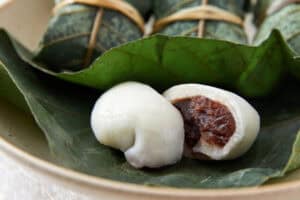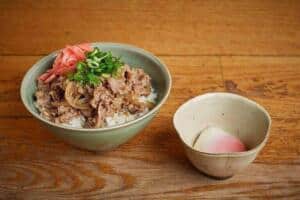If you are interested in local cuisine from Akita Prefecture, you might want to try Kiritanpo, a unique dish made from mashed rice that is wrapped around a cedar skewer and grilled over charcoal. This article introduces the history and features of Kiritanpo, as well as some recommended shops where you can enjoy this traditional Japanese dish that has been loved by locals for generations. Don’t miss this opportunity to experience the taste of Akita region and discover the secrets of this delicious dish.
Introduction to Kiritanpo
Kiritanpo is a traditional food in Akita prefecture which consists of half-smashed rice shaped into a cylindrical one and toasted on the fire. It is considered a pounded rice snack in Akita. They mash the rice with a pestle and skewer it then bake it. Another traditional food that is a specialty of Akita prefecture is Jyumonji Ramen.
Because Kiritanpo’s main ingredient is rice, rice is a staple food in Japan. Many Japanese people may find subconscious comfort in the aroma of Japanese rice, filled with a slight sweetness and ample moisture. Japanese people have been economically and emotionally deeply connected to rice since ancient times.
Etymology
The etymology for the name of Kiritanpo means “a bottle of rice.” However, if we translate each word, “Tanpo (たんぽ)” means “dandelion.” Locals name it like that because its shape is similar to that of a spear’s tip cover. But Tanpo is food where locals pound the rice to bring out its glutinous nature and they grill it on a cedar skewer. Meanwhile, the “Kiri (きり)” means “cut”, meaning that it is just a cut version of the tanpo that locals introduced before.
Origin of Kiritanpo

Many stories explain when and why the Japanese created this masterpiece. To begin with, it originates from the Hokuroku area in Odate City in Akita prefecture. Japanese ancestors will go to the mountains to burn charcoal and cut timber. The rice in the mountain lodge tends to spoil easily if it is left as it is. They will wrap it thinly around a stick and boil it to keep it for a long time.
In the old times, this was a meal of hunters and woodcutters because it was portable and pretty easy to make. After the farming work, they knead the leftover rice, roll it on a skewer, and put it into the tori-nabe (chicken pot), or add miso paste to them. Additionally, they will also This dish starts as an offering to Odate at first. We can say that Kiritanpo is a true signature dish of Japanese food.
What is Kiritanpo?

Kiritanpo (きりたんぽ) is a traditional food in Japan that consists of cylindrical half-smashed rice placed on a skewer. It freshly boils new rice and toast on cedar skewers. In Akita prefecture, locals mash the rice with a pestle and squeeze it into a stick, then, they will bake it. Locals usually place kiritanpo in a hotpot with chicken, green onions, Japanese parsley, and mushrooms, but they also grill kiritanpo over the fire together with miso. You can also eat miso as “miso-yaki tanpo”, but the most famous one is the Kiritanpo hotpot. The origin of Kiritanpo was to apply miso to the tanpo.
Regardless of how rich or poor a farmer may be, kiritanpo is an essential part of festivals celebrating the year’s harvest reaped by the farmers. Kiritanpo nabe, a kind of soup often made not just in winter but at New Year’s, the Bon festival, and when a family returns home, originates in Odate, a city in northern Akita. The soup stock is from hinai-jidori chicken, a local specialty.
Kiritanpo Recipe

The main ingredient of Kiritanpo is rice. It should be the one from the new harvest. Japanese also adds salted water to it later. The next thing that you need is 30cm long cedar sticks to make this dish. Additionally, miso paste is optional.
How to make Kiritanpo?
This dish is usually cooked at home, and there are different variations of recipes for kiritanpo.

Rice should be hard-cooked before transferred into a mortar, where it’s mashed.
After that, it’s wrapped around the cedar sticks. 0-5-1cm of thickness should be perfect. It’s very important to mash it properly, otherwise, the rice will crumble from the sticks.
Then, the sticks with rice are grilled and optionally topped with miso paste.
What was originally the seasoning of Kiritanpo?

The seasoning for Kiritanpo was completely different at that time. At the time of the birth of Kiritanpo, the salty sauce was not a common seasoning but a luxury product only for some people. Additionally, Hinai chicken is not yet born at the time of its birth.
What are the health benefits of Hinai chicken?
Compared to broilers, Hinai chicken contains a large amount of inosinic acid which is an umami ingredient. In addition, recent research results have revealed that it contains a large amount of arachidonic acid, which is one of the fatty acids that make up fat. In addition, the muscle fibers that make up the muscle are thicker than the broiler, so it is chewy. These are the secrets of the deliciousness of Hinai chicken.
What are the main types of Kiritanpo?
Tanpo mochi
Tanpo mochi refers to kiritanpo before they cut it. However, most people think of this as “Kiritanpo,” but it is strictly wrong because the tanpo mochi is not yet cut.
Miso Tanpo
The locals mixed the miso to a baked tanpo and ate it as it was.
Kiritanpo Nabe
It refers to the hotpot made of kiritanpo. Locals make this by adding soy sauce-flavored soup based on the soup stock taken from chicken (Hinai Jidori).
- What type of rice is used in Kiritanpo?
arieties such as Akita Komachi and Sasanishiki are often used as ingredients in Kiritanpo.
- What does kiritanpo nabe soup taste like?
It is a soy sauce-based soup with Hinai Jidori chicken broth.
Recommended Kiritanpo Restaurants
If you are in Japan, I highly recommend trying kiritanpo that is a traditional food in Japan. It’s very popular among Odate’s inhabitants, so you won’t have trouble finding a good restaurant that serves this tasty traditional meal. Probably the best time for it is autumn when locals make new rice. There are many events where kiritanpo is with hinaijidori chicken(one of the famous chicken breeds in Japan) because it’s usually a part of every local festivity.

Kiritanpoya restaurant
As its name suggests, this restaurant specializes in this dish. It is said to be the best restaurant in Akita that serves Kiritanpo. The restaurant is located outside the Akita JR train station. When you pass the bus terminal, you will easily see it on the west exit. As soon as you enter it, you will feel the real spirit of the Japanese countryside. There are even fake rice fields and flickering fireflies inside. In front of you, there is a traditional fireplace, where fresh kiritanpo is made. If you have never tried it before, I suggest you order nabekko, a hot pot version of this dish.

Kiritanpo in nabekko is served sliced, in rich chicken broth mixed with dark soya sauce or Japanese wine, alongside slices of meat, vegetables, and maitake mushrooms. The prices vary, but the smallest portion is 1580 JPY. The biggest one is 4,580 JPY, and it can be served to up to 5 people. If you order it, it will be made right in front of your eyes.
I advise you to book a table one or two days in advance if you want to go to this restaurant since it’s quite popular.
Akita Hinai Jidoriya
If you have to wait for a train or a shinkansen, why don’t you kill time by looking for a good place to stay and eat something delicious? One of the most recommended restaurants in Akita is this one, and it’s located on the 3rd floor of the train station, although some travelers claim that it’s not so easy to find. The food and service are highly satisfying, and here you can enjoy a fresh, delicious kiritanpo soaked in broth with soft and tender slices of hinajidori chicken for the price of 1,800 JPY. It has even won a certificate of excellence in 2019.

Tazawa Kogen Hotel
If you choose to stay in a hotel, you should think about the Tazawa Kogen hotel. Not only are you able to enjoy their excellent service, but also to relish a great view of beautiful mt. Komagatake.
Here you can try Kiritanpo as well, which is on the hotel menu. It’s full of aroma, and it’s also cooked at a fireplace. It’s recommended by both travelers and locals.
Akitasugi
This is another place where you can enjoy kiritanpo, but since it’s not so spacious, you should book a table in advance.
The average price of a single meal is around 4,500 JPY.
Namahage Ginzaten
If you want to experience something authentic and fun, especially something related to Japanese folklore, then this place would be a perfect choice of yours. The interior is based in the manner of a Japanese hut, and as soon as you come in, there is a red demon from Japanese folklore (oni) to greet you. Kiritapo here is fresh, but the portions are not too big. Also, every hour, there is a mini-show, where the red demon walks around and interacts with the diners.
It’s located on the 9th floor of the building in Ginza.

Masaki
This place is not so far away from Kitasenju station, and it’s worth coming. Here you can eat a great kiritanpo nabe with yakitori, combined with other fresh ingredients. The price of one serving is 1800 JPY and you can get the chicken meat upgrade for an additional 500 JPY.
Conclusion
Akita Prefecture in particular is a famous place for rice production, with brands such as Akita Komachi and Hitomebore produced here. Just as the prefectural name “Akita” (autumn rice fields) suggests, rice supports the lives of those who live in this prefecture, changing its form in a variety of foods. When asked what a typical local food from Akita was, many Japanese people would probably answer the same way; Kiritanpo. Japanese eat Kiritanpo from October to February in winter, especially before it snows in mid-November.
















Comments